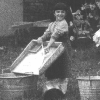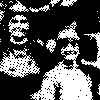 JPG photo of laundresses, 19 kB
JPG photo of laundresses, 19 kB
 JPG photo of female threshers, 108 kB
JPG photo of female threshers, 108 kB
Costantino Nigra, the most important scholar of Northern ballads, was an exception. In his Canti popolari del Piemonte (1888), Nigra transcribed most of the songs from peasant women's dictation and singing. Much of the rest of his collection was gathered by contributors who worked with the same methodology. Nigra mentions three important informers: Domenica Bracco, Teresa Croce, and Teresa Bertino from Castelnuovo, in Piedmont (Nigra 1974:xxxi-ii). He overtly acknowledges the role of peasant and shepherd women in maintaining the "poetic treasury" of Italian ballads (ibid:xxxiii). From Nigra's testimony, we can assume that during the second half of the nineteenth century, ballads were commonly sung by women.
 GIF photo of grapepickers, 14kB.
GIF photo of grapepickers, 14kB.
One commonly reads and hears that singing accompanied women's work
inside or outside the house: spinning, weaving, sewing, washing,
farming, and such tasks.
 JPG photo of laundresses, 19 kB
JPG photo of laundresses, 19 kB
 JPG photo of female threshers, 108 kB
JPG photo of female threshers, 108 kB
Until the beginning of the 1950s, these tasks were essentially collective and
related to the organization of the family in the countryside. In the
lowlands, the prevailing model was the "multiple family household"
(Laslett 1972, Poni 1982, Fumagalli 1977), a number of related
nuclear families living together under the authority of a chief, the
reggitore.
 JPG photo/GIF key of multiple family, 75 kB
JPG photo/GIF key of multiple family, 75 kB
The chief ruled the community of his unmarried sons and daughters and married sons' families. His wife, the reggitrice, who also depended on the reggitore, ruled all women living in the household and was in charge of domestic tasks (Guidicini and Alvisi 1994). In other kinds of communities, like the frerèches, related families of brothers lived together and one of the brothers acted as reggitore (Poni 1982:286). In these kinds of communities, collective work was the rule for the women living in the household and often the occasion for singing. With reference to the twentieth century, until the eve of the Second World War, the Bettinelli sisters (Mantovani 1979), well-known performers of Italian balladry living at Ripalta Nuova in Lombardy, connect singing with working in the fields and on the farm with the other women of the farmhouse. Singing ballads or listening to ballads seems to have been one of their principal means for women to perform in a group.
A same-gender relationship was important in a society where to be male or female made a difference from the beginning of life. A male child was welcome in a family since he represented a source of labor. The birth of a female child was considered a burden since she must be supported until she grew up, then left the family to get married. Moreover, she would require a dowry to get married. The relationship between men and women was not equal, but hierarchical. A woman was always subjected to the authority of a father, husband, or reggitore (Poni 1982, Mantovani 1979). Group activity through ballad singing may have been an important way for women to reinforce the values of solidarity and community.